|
Learn more about some common lawn weeds and how to deal with them.
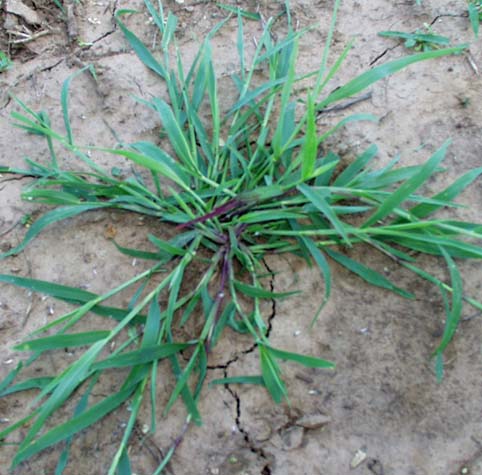
Crabgrass is a warm season annual weed that invades lawns that are thin, weak and undernourished. It germinates from seed in late spring once soil temperatures have reached 50 F (10C). During the summer it develops into a ground-hugging weed that spreads over the surrounding grass. In late summer it produces hundreds of seeds that will sprout the following year. Crabgrass seeds can remain in the soil for many years and sprout when the soil is disturbed.
Organic Solution:
The best defense is a good offense. Regular overseeding of your lawn will encourage a dense root system which will not provide space for Crabgrass to grow. Crabgrass is very rare in thick, healthy lawns that are mowed to a height of 3 inches (7.6 cm) this helps to keep the soil cooler thus inhibiting germination of Crabgrass seeds.
If you have had Crabgrass in the past, in early spring give the area a hard raking to dethatch it and remove the debris. You can then apply corn meal gluten, which will act as an organic pre-emeregent herbicide. Please note that since corn meal gluten is a pre-emergent, you cannot overseed your lawn until the fall if you use corn meal gluten in spring. The best way to organically control Crabgrass is to ensure that you keep your lawn mowed in late summer when the Crabgrass is putting up its purple seed stalks. This will prevent it from making seed for the future.
Non-organic Solution: Often, by the time Crabgrass is noticeable it is too late to treat, however there are chemical crabgrass treatments. Contact your local garden centre or hardware store for options in your area.

Dandelions are the bane of many peoples lawns. Thriving in thin, sparse turf, dandelion seeds float through the air looking for the slightest opening in the lawn to propagate. Meanwhile, below ground, they develop a taproot up to 10" long. This taproot is thick but brittle and easily fractures and any piece of the taproot that remains in the ground will re-grow.
Organic Solution:
Regular overseeding of your lawn will encourage a dense root system which will not provide space for Dandelions to grow. Leave grass clippings on the lawn as they act as mulch helping to prevent Dandelion seeds from germinating. That said, if you do have Dandelions there are very few organic options. If there are only a few of them, you can dig them out by hand, try to get as much of the root as possible. There is also a biological agent called "Sarritor" which is a fungus that selectively attacks dandelions and some other broad leafed weeds while not harming grass. Check with your local garden centre or hardware store to see if they stock it. Another alternative is to pour boiling water on Dandelions as boiling water kills any and all plants. If you use boiling water you will need to re-seed the affected areas.
Non-organic Solution: If you are using a broadleafed herbicide, use one where the active ingredient is 2-4-D. The ideal time to use herbicides on Dandelions is in early fall when the leaves are transferring nutrients down to the roots. Herbicide applied in early fall will be absorbed by the leaves and passed on down to the roots.
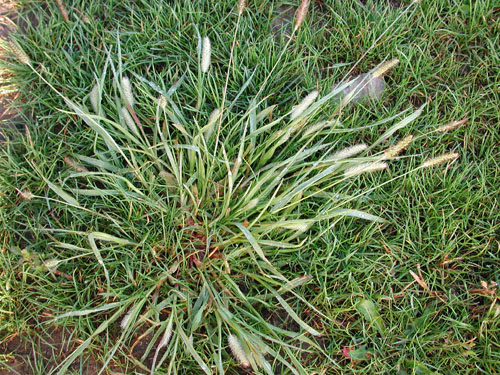
Native to Europe, Quackgrass is easy to identify. It produces long, wide-leafed grass and the grass blades have a rough almost burr-like feel to them. The thick, white roots form deep, dense mats and these roots tend to break easily when pulled leaving pieces in the soil after the grass has been removed. Any pieces left in the ground will quickly re-grow into new plants.
Organic Solution:
Again, the best defense is a good offense. Regular overseeding of your lawn will encourage a dense root system which will not provide space for Quackgrass to grow. Unfortunately, there are no organic products that are effective at eradicating Quackgrass. If the area affected is small, digging it up is a good option but be sure to get all of the roots. Frequent mowing is also an effective way to control this as mowing prevents Quackgrass from making seeds for the future. Be sure to keep the mowers blades set to a height of 3 inches. Another option to prevent Quackgrass from germinating is to apply Corn Meal Gluten in early spring as this acts as a pre-emergent herbicide. Please note that since corn meal gluten is a pre-emergent, you cannot overseed your lawn until the fall if you use corn meal gluten in spring. A further alternative is to pour boiling water on Quackgrass as boiling water kills any and all plants. If you use boiling water you will need to re-seed the affected areas.
Non-organic Solution: Spot spay in early spring or early fall with a non-selective herbicide containing glysophate (Round Up). As this also kills turf, you will need re-seed the areas you have sprayed.
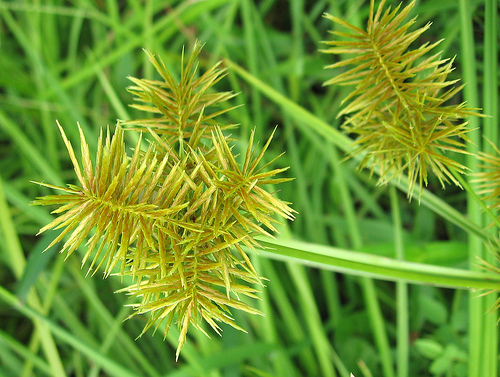
Also known as Nut Grass, this wide-bladed bright green sedge grows at warp speed. Each grass blade has a thick mid-vein and a waxy coating. It has a shallow root system that produce many nut-like tubers which are underground food storage for the plant. Each tuber has up to seven viable buds and each one can grow and produce new plants. Each new plant also produces rhizomes that create new plants.
Organic Solution:
The most thorough way to rid your lawn of nut grass is by removing the entire plant, roots and all by digging it out by hand. Or you can coat the grass in sugar as an organic alternative.
Removal by Hand
Insert a gardening trowel directly next to the nut grass. Dig down as far as you can go. Nutsedge root systems can extend as deep down as 12 to 18 inches (30 to 46 cm) below the surface.
Gently pry the plant, roots and all, out of the ground. Doing this gently is vital to reduce the number of roots that break off, as well as the number of pieces those roots break into. Dig out any stray roots. If any roots remain, there is still some chance that the nutsedge can return.
Put the weeds into a garbage bag, along with the soil you dug out simultaneously. Dispose of the weeds in your trash. Do not throw them into a pile or into a compost heap, since you may end up spreading them into another area of your lawn by doing so.
Using Sugar
This method is most effective at the start of the growing season, when nutsedge is just barely beginning to germinate and sprout. Start by watering the lawn. You do not need to soak it, but the lawn should be evenly moist down to the soil.
Next sift sugar over you're the lawn. Walk up and down the lawn in straight lines and at a steady pace. Pour the sugar through a sifter as you walk, continually turning the handle of the sifter. Make sure that the sugar falls on the grass in even amounts. This is no mere folk remedy. Sugar actually "eats" the nutsedge while also providing nourishing microbes that have a positive effect on your lawn.
Water the lawn once more, don't saturate the grass, since that would wash the sugar away. Spray the lawn with a light mist, providing just enough water to re-moisten the blades of grass and coax the sugar down into the soil and the roots of the lawn.
Repeat this procedure at least twice more throughout the spring. The nutsedge may not die off completely after the first treatment but after a few applications of sugar all of it should be dead.
Non-organic Solution: Use herbicide before the nutsedge develops five true leaves. Leafy nutsedge has too many obstacles, preventing herbicides from sliding down to the "nuts" and the root. Herbicides work best early in the season, while nutsedge is still young and has minimal leaves.
Select an appropriate herbicide. Products that contain MSMA or products with a chemical called bentazon work best. Nutsedge is a common enough problem, so herbicides that work against the weed will be labeled as " nutsedge or nut grass killers."
Allow your lawn to grow for a few days prior to application. Herbicides works best when the nutsedge is growing vigorously and may not be as effective if applied immediately after cutting it down. Wait two or more days after your last lawn mowing before applying the chemical to the lawn.
Apply the herbicide during a dry period. Wait several days after your last watering and do not spray the herbicide if you may get rain four hours after application or if you expect heavy rains to follow in coming days. Water will wash the chemical away and it may not have the chance to do its job before that happens.
Read the instructions on the label of your herbicide bottle to determine how to apply it properly. You will usually spray diluted MSMA herbicide over your entire lawn. For instance, the instructions may tell you to mix 1.5 ounces (45 milliliters) of chemical into 5 gallons (20 liters) of water to treat 1000 square feet (92.9 square meters) of lawn.
Repeat the treatment several times during the growing season. Eco-Lawn may need four to eight applications before the nutsedge dies off completely.

Typically occurring in shady, damp acidic soils, moss spreads through spores.
Organic Solution:
The best way to effectively and permanently eradicate moss in the lawn is to physically remove the moss. Start by raking the area with a hard rake to loosen it. Then using the edge of a flat shovel, scrape away the moss and remove the debris. Next, top dress the area with compost and to seed it with Eco-Lawn seed. Eco-Lawn is far more shade tolerant than most turfs and will out-compete moss growth. If the affected area has heavy or compacted soil, it is a good idea to loosen the soil to a depth of at least 3 inches and re-grade to allow drainage before sowing Eco-Lawn. You can also make a spray consisting of 4 ounces of dish soap to one gallon of water and drench the moss with the solution. The moss will turn orange/brown in 24 hours and will dry up.
Non-organic Solution: There are a number of moss killing pesticides such as "Moss Out!" available. Contact your local garden centre or hardware store for options in your area.
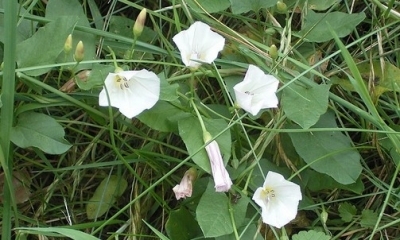
Bindweed is a vining plant that snakes across the ground. It has arrow shaped leaves and white/pink flowers that look like morning glories. Bindweed can grow four feet or more in length and develops deep roots.
Organic Solution:
Vigilance and persistence are required to control Bindweed, where you see it, cut it off at the soil level. Don't try to pull it out as it will just re-sprout from its roots. By continually cutting it off at ground level as often as you can, will prevent the Bindweed from experiencing photosynthesis and thus it will eventually starve to death. Another alternative is to pour boiling water on Bindweed as boiling water kills all plants. If you use boiling water you will need to re-seed the affected areas.
Non-organic Solution: Spot spay in early spring or early fall with a non-selective herbicide containing glysophate (Round Up). As this also kills turf, you will need to re-seed the areas you have sprayed.

White Clover also known as Dutch Clover is a cool-season perennial that is native to Europe and Asia. Low growing, it forms creeping stems (stolons) that produce roots and shoots along its stem. Being in the legume family, it fixes nitrogen into the soil which enables it to thrive in unfertilized areas.
Organic Solution:
There are very few organic controls for White Clover in the lawn. Corn Meal Gluten applied in early spring acts as a pre-emergent herbicide which will stop new White Clover seeds from germinating. Please note that since corn meal gluten is a pre-emergent, you cannot overseed your lawn until the fall if you use corn meal gluten in spring.
If you must get rid of established clover in the lawn hand pulling is the only really effective way. Time your hand pulling to be after the lawn has received a good, long rainfall or water the lawn very deeply before trying to hand pull them. A very moist soil will make the hand pulling a lot easier.
Non-organic Solution: Any commercial broadleafed weed killer will be effective on White Clover. Contact your local garden centre or hardware store for options in your area.
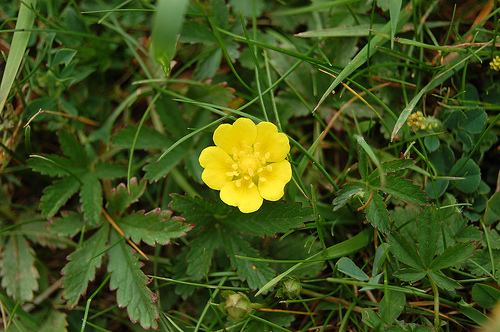
This perennial weed is often found in neglected lawns. It has a vigorous creeping habit as it spreads with creeping stems that take root at intervals along its way. The leaves of Cinquefoil resemble those of wild strawberry with each leaf having five heavily toothed leaflets. It produces yellow flowers with five heart shaped petals.
Organic Solution:
If there are not too many of them, hand weeding is effective. Raking the lawn prior to mowing will also help to weaken and discourage it.
Non-organic Solution: Chemical controls will require repeated applications to totally eradicate Cinquefoil. Contact your local garden centre or hardware store for options in your area.

Black Medic also called Yellow Trefoil is an annual species so it only lives one year but it makes a lot of seeds that can remain viable for several years.
It's seeds germinate in the spring and are capable of establishing in drought-prone or disturbed soils. Black medic is a legume, meaning that it has the capabilities to fix its own nitrogen; thus, allowing it to out compete turf in nutrient-poor soils as well. These factors, in combination with its ability to tolerate low mowing heights, make black medic a common weed in lawns.
Organic Solution:
Black medic is not shade tolerant, therefore the development of a thick, dense turfgrass canopy helps improve competition against it. Unfortunately repeated hand pulling is really the only good option, especially before it start to make seeds. You can also try using either a vinegar based or citric acid organic herbicide.
Non-organic Solution: A broadleafed weed killer that contains a combination of 2-4-D, dicamba and MCPP/MCPA will be effective. Contact your local garden centre or hardware store for options in your area.

Creeping Charlie is a very aggressive lawn weed that is difficult to control when established in lawns. It has low growing, creeping stems that form new plants where they root at its nodes. The creeping, spreading, invasive nature of this weed, along with its preference for shady places makes it very competitive in lawns.
Organic Solution:
Repeated physical removal of Creeping Charlie by pulling or hard raking will, over time, prevent the Creeping Charlie from experiencing photosynthesis and thus it will exhaust its stored energy supply.
Research at Iowa State University found that borax can be used to selectively control Creeping Charlie in turf. To do so, dissolve 1 ounce of borax in 2-3 gallons of water and apply the solution uniformly over each 1,000 sq. ft. area. For small infestations dissolve 5 teaspoons of borax in one quart of water, this covers 25 sq. ft. Do not re-apply borax solutions more than once a year as borax contains boron, too much of which can be toxic to your lawn.
Non-organic Solution: A broadleafed weed killer that contains a combination of 2-4-D, dicamba and MCPP/MCPA will be effective. Contact your local garden centre or hardware store for options in your area.

Broadleaf plantain is a perennial weed that tolerates a wide variety of growing conditions such as, dry soil, wet soil, heavy clay soil and low mowing heights. Left undisturbed, plantain can grow as much as 12 inches across and 2 feet tall.
Organic Solution:
If there are not too many of them, hand weeding is effective. Try to remove as much of the root system as possible. You may need to moisten the soil before trying to pull it out as it does make a deep tap root. Note: you may need to repeat this throughout the summer.
Non-organic Solution: Spot spay in early spring or early fall with a non-selective herbicide containing glyphosate (Round Up). As this also kills turf, you will need to re-seed the area. |
|











